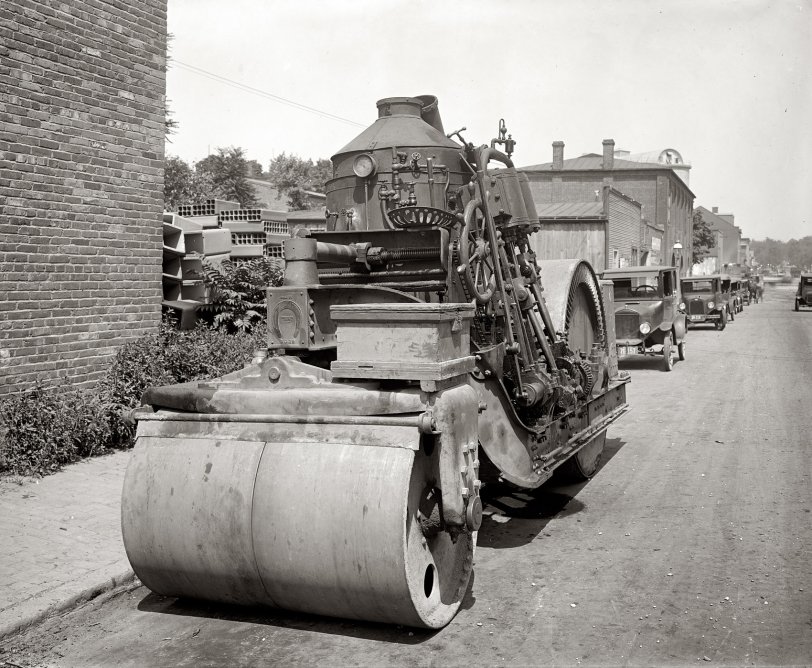


Framed or unframed, desk size to sofa size, printed by us in Arizona and Alabama since 2007. Explore now.
Shorpy is funded by you. Patreon contributors get an ad-free experience.
Learn more.

- Freeze Frame
- Texas Flyer wanted
- Just a Year Too Soon
- WWII -- Replacing men with women at the railroad crossing.
- Yes, Icing
- You kids drive me nuts!
- NOT An Easy Job
- I wonder
- Just add window boxes
- Icing Platform?
- Indiana Harbor Belt abides
- Freezing haze
- Corrections (for those who care)
- C&NW at Nelson
- Fallen Flags
- A dangerous job made worse
- Water Stop
- Passenger trains have right of way over freights?
- Coal
- Never ceases to amaze me.
- Still chuggin' (in model form)
- Great shot
- Westerly Breeze
- For the men, a trapeze
- Tickled
- Sense of loneliness ...
- 2 cents
- Charm City
- What an Outrage
- Brighton Park
Print Emporium
The Flattenator: 1925

Washington, D.C., circa 1925. "Crawford Paving Co." Steamroller made by Barber Asphalt Paving of Buffalo, N.Y. National Photo glass negative. View full size.
Terra Cotta Pipe Sections
The ones divided into six sections, known as a "six-way clay conduit," are used for running telephone & telegraph wires underground. I happen to live in the house of a man who made a good living in the manufacture of them. One of his largest customers was Western Electric. These conduits are responsible for helping clean up the tangle of overhead wires - seen in many of Shorpy's early street views - by taking them below ground and out of sight. As a side note, his factory would sell the second quality conduits to many of the farmers and residents around town who would use them to build garages & outbuildings, many of which still stand today.
Re: Where in D.C.?
From another Crawford Paving photo, here's that siloish building seen above. With ROSSLYN spelled out across the top. Click to enlarge. Maybe near the White Dome shortening plant.
Where in D.C.?
Anybody have any ideas where this is? The building in the distance with the semicircular roofline is a real curiosity -- looks a bit like a grain elevator. Also suggestive of an observatory of some type. Very strange to see an arched metal roof in the pre-Quonset hut era. There is also a "jog" in the street in the distance suggesting a public square or bridge.
[There is one last photo on this series that may contain a clue. I'll post it later tonight. - Dave]
Dave, your tease! I'm tingling with excitement in anticipation.
Betsy?
Looks a bit like Betsy in Disney's "Cars" to me. No power steering in those days, just muscle and then some. There's a thriving steam scene over here in Britain where all sorts of people restore and show these sort of machines. Quite a sight when there are hundreds all together!
Their good luck fell out!
Didn't Barber know that you're supposed the put the horseshoe with the open end up, to keep the good luck from spilling out?
Also note the terra cotta pipe sections on the left. Standard plumbing fare in the 1920s.
[They look like chimney liners. - Dave]
23-Point Turns
I've used the term "steam roller" my whole life to describe modern road flattening machines, but this is the first time I've actually seen one powered by steam. I love how the crankshaft is right out there in the open, ready to mangle an arm or two. Does that chain connected to the steering wheel provide some sort of power assist? With that screw gear steering system, it was probably quite a job to change direction even while moving.
External Drive
Interesting that the drive train, including the cylinders, is external to the body. And with direct gear drive to the wheel! Sorta kinda similar to a Shay locomotive.

























On Shorpy:
Today’s Top 5